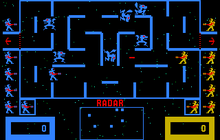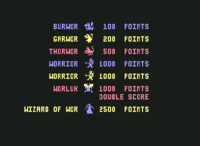Wizard of Wor
Wizard of Wor is an arcade game released in 1980 by Midway. Up to two players fight together in a series of monster-infested mazes, clearing each maze by shooting the creatures. The game was ported to the Atari 8-bit family, Commodore 64, Atari 2600, and Atari 5200 and renamed to The Incredible Wizard for the Bally Astrocade. The original cartridge came with a cash prize offer to the first person to complete the game.
| Wizard of Wor | |
|---|---|
 Arcade flyer | |
| Developer(s) |
|
| Publisher(s) |
|
| Designer(s) | Tom McHugh[1] Dave Nutting[1] |
| Platform(s) | Arcade, Atari 8-bit, Atari 2600, Atari 5200, Bally Astrocade, Commodore 64 |
| Release |
|
| Genre(s) | Maze |
| Mode(s) | Single-player, 2 player simultaneous |
| Cabinet | Standard upright, Mini upright, Cocktail[2] |
| Display | Raster |
Gameplay

The players' characters, called Worriors, must kill all the monsters by shooting them. Player one has yellow Worriors, on the right, and player two has blue Worriors, on the left. In a two-player game, the players are also able to shoot each other's Worriors, earning bonus points and causing the other player to lose a life. Team-oriented players can successfully advance through the game by standing back-to-back (such as in a corner) and firing at anything that comes at them.
Each dungeon consists of a single-screen rectangular grid with walls and corridors in various formations. The Worriors and the monsters can travel freely through the corridors. Each dungeon has doors at the left and right edges, which connect with each other, making the dungeon wrap around. Whenever a door is traversed by a player or monster, both doors deactivate for a short period, making them impassable. A player who exits the door can pop back through the door immediately when the Worluk or Wizard is in the dungeon. A small radar display indicates the positions of all active monsters.
As long as a player has at least one life in reserve, a backup Worrior is displayed in a small sealed cubbyhole at the corresponding bottom corner of the dungeon. When the current Worrior is killed, the cubbyhole opens and the player has 10 seconds to move the backup into play before automatically being forced in.

The various monsters include the following:
- Burwor: A blue wolf-type creature.
- Garwor: A yellow Tyrannosaurus rex-type creature.
- Thorwor: A red scorpion-like creature.
- Worluk: An Insectoid-type creature.
- Wizard of Wor: A blue wizard.
Both Garwors and Thorwors have the ability to turn invisible at times, but will always appear on the radar. All enemies except the Worluk can shoot at the Worriors.
Each dungeon starts filled with six Burwors. In the first dungeon, killing the last Burwor will make a Garwor appear; in the second, the last two Burwors are replaced by Garwors when killed; and so on. From the sixth dungeon on, a Garwor will replace every Burwor when killed. On every screen, killing a Garwor causes a Thorwor to appear. There will never be more than six enemies on the screen at once. From the second dungeon on, after the last Thorwor is killed, a Worluk will appear and try to escape through one of the side doors. The level ends when the Worluk either escapes or is killed; in the latter case, all point values for the next dungeon are doubled.
The Wizard of Wor will appear in or after the second dungeon once the Worluk has either escaped or been killed. After a few seconds the Wizard will disappear and teleport across the dungeon, gradually approaching a Worrior. The Wizard remains in the dungeon until he shoots a Worrior or is killed. He uses a speech synthesizer to taunt the players throughout the game.
Players are referred to as "Worriors" during the first seven levels, then as "Worlords" beyond that point. The "Worlord Dungeons" are more difficult than the earlier levels because they have fewer interior walls.
There are two special dungeons with increased difficulty. Level 4 is "The Arena," with a large open area in its center, and Level 13 is "The Pit," with no interior walls at all. A bonus Worrior is awarded before each of these levels. Every sixth dungeon after Level 13 is another Pit. A player who survives any Pit level without losing a life earns the title of "Worlord Supreme."
Each dungeon begins with a dramatic rendition of the five-note opening from "Danger Ahead"—the theme to the radio and television series Dragnet—with the fifth note only playing on the "double score dungeon" screen.
Reception
Wizard of Wor was moderately successful in arcades.[3]
Electronic Games called the Atari 8-bit version "outstanding." It similarly praised the arcade version, stating that while one-person and competitive two-person play was excellent, two people cooperating was "a unique playing experience".[4]
Danny Goodman of Creative Computing Video & Arcade Games called The Incredible Wizard for the Astrocade "an incredibly good replica" of Wizard of Wor.[5] Video magazine's 1982 Guide to Electronic Games agreed, calling it "a near-perfect translation" of the arcade original.[6]:53 It would go on to be awarded "Best Multi-Player Video Game" at the 4th annual Arkie Awards where it was described as "the finest cartridge ever produced for [the Astrocade]",[7]:30 and the Atari version would be honored at the 5th Arkies with a Certificate of Merit in the same category.[8]:29
Legacy
Wizard of Wor is included in the compilations Midway Arcade Treasures 2 (2004) and Midway Arcade Origins (2012).[9]
References
- Hague, James, The Giant List of Classic Game Programmers
- Wizard of Wor Parts and Operating Manual, Article retrieved 2011-10-19.
- Pearl, Rick (June 1983). "Closet Classics". Electronic Games. p. 82. Retrieved 6 January 2015.
- "The Players Guide to Fantasy Games". Electronic Games. June 1983. p. 47. Retrieved 6 January 2015.
- Goodman, Danny (Spring 1983). "Home Video Games: Video Games Update". Creative Computing Video & Arcade Games. p. 32.
- Kunkel, Bill; Katz, Arnie (November 1982). "Video's Guide to Electronic Games". Video. Reese Communications. 6 (8): 47–56, 108. ISSN 0147-8907.
- Kunkel, Bill; Katz, Arnie (February 1983). "Arcade Alley: The Fourth Annual Arcade Awards". Video. Reese Communications. 6 (11): 30, 108. ISSN 0147-8907.
- Kunkel, Bill; Katz, Arnie (February 1984). "Arcade Alley: The 1984 Arcade Awards, Part II". Video. Reese Communications. 7 (11): 28–29. ISSN 0147-8907.
- http://www.ign.com/articles/2012/11/14/midway-arcade-origins-review
External links
- Arcade gameplay at the Internet Archive
- Wizard of Wor can be played for free in the browser at the Internet Archive
- Commodore 64 box and manual at C64Sets.com